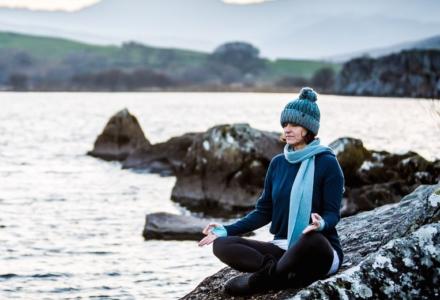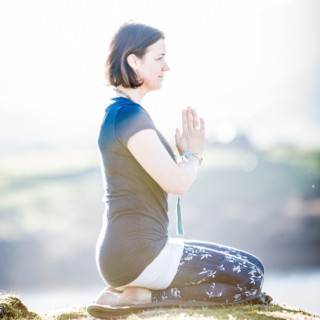
Are we sitting comfortably?
One thing that held me back when I was learning to meditate was that I could not get comfy. My back would start to ache, pins and needles in my legs, or I would start to nod off! How do we sit with comfort and poise so that we can actually get to meditate?

A tall spine keeps you focused for meditation.
So, to begin, it is helpful if we can drop the goal of sitting in perfect lotus pose and looking like an Instagram superstar when we meditate. I usually meditate in my pyjamas or in my wellies in my favourite woods. It’s really not that glamorous! Remember it’s what’s going on, on the inside, that counts!
Think like a giraffe.
Posture is key for seated meditation. For seated meditation, the most important thing is a tall spine. Not a straight spine, but a tall one. Think like a giraffe... Tall and elegant!! Look at the photo on the right, see how my spine has curves in it; I’m sitting up ‘straight’. Yours will do this too. It’s meant to do that!
Engage your core slightly, lift your chest, take a deep breath in and lift the crown of your head up to the sky. Try it now, just sitting wherever you are. On your out-breath, let the shoulders relax but keep the feeling of being tall and lifted, as if you are a puppet with a string pulling you up, up, up.
So, if you can feel into that, and you already feel more present, then hopefully you can see that it doesn’t matter if you are sitting on a chair, a cushion, a meditation stool, a park bench, a seat on the bus. If you are sitting on a chair, just don’t lean and slump into the back of it. Support your spine with your own core muscles, deep in the belly. If possible have a support under your sit-bones; it is usually more comfortable with the knees lower than the hips.
Cheating Gravity makes it easier!
Now. See if you can sway gently forwards and backwards, and feel the pull of gravity on your shoulders, wanting to pull you down to the centre of the earth and the effort it takes to pull away from that force of gravity. Now, we want to cheat gravity and become invisible to it. So, find the sweet spot, where your shoulders balance perfectly above your hips, the crown of your head perfectly aligned with your seat... and all effort ceases. Take a breath here. You’re doing great!
Now, the next thing to tackle is the ‘nodding dog syndrome’. We get sleepy if we relax the chest forwards, so start to roll the shoulders forward slightly and the space between the shoulder blades opens. OH NO! You have just switched on your Relaxation Response… snore… Quick! Push the chest up, imagining a hand placed under the shoulder blades gently pushing you forward and up. Alert response! Phew! That was close.
Lastly, how to breathe?
Breathing only into the belly, again, triggers the dreaded Relaxation Response. Breathing only into the chest triggers too much of the Alert Response. So let’s combine the two. Take a deep in-breath and split it into two parts, send the first half into the belly, the second half into the chest. Pause. Pull the tummy muscles in a bit more (you still have your core switched on, right?) and let the breath out gently and slowly, like a deflating balloon... Pause and begin again. A few rounds of this breath will help you to feel settled and present. After 4 or 5 rounds, let the breath soften and find a natural easy rhythm. Keep checking your posture as you watch your breath. Stay a bit longer. You can do it!
Notice what has happened in your mind... ?? Has it also settled, just a little. Do you already feel calmer, more present, more at ease?
Remember we call our time on our mats / cushions / chairs our PRACTICE, and 'practice makes perfect' so keep practising, even if just for 5 minutes a day, ficus on your posture and your breath and meditation will come easily once you have arrived here...
Meditation is a vital practice to access conscious contact with your highest self.
Dr. Wayne Dyer